In the last few years, I've developed a passion for cooking--for the smells, tastes, colors, textures of food, and for the delight that people can experience eating food that is prepared with love and creativity. There's something both meditative and artistic, I find, in imagining a meal and then bringing it into being.
I think that my love of cooking and my desire to become healthier were the two driving forces that brought me to begin farming, though that journey has taken a couple of years. Earlier on, the idea of buying organic food seemed like a luxury and a hassle at once. My local corner grocery store didn't carry much fresh food, and the vegetables in the produce aisle cohabited with the owners' cat. Trekking into Manhattan took time. I managed to become a pretty decent cook with canned and frozen items, but we ordered in quite a bit, too! Then, a few years ago, a grocery delivery company started delivering in my neighborhood. It was great, for awhile, until I became completely disgusted with the amount of plastic packaging used...Every week, we were throwing out a seemingly endless sea of containers. And while that company offered many freshly prepared foods, they were expensive.
Last summer, I realized that I'd been going to the gym for about a year, given up smoking (again!), and wasn't seeing many changes. I switched to a new trainer, who had me write down everything I ate, every day, and show it to her. This was an invaluable activity--it really made me notice food. I was already eating pretty healthily--yogurt and fruit, veggies and pasta, lean meats and grains and salad--but just writing everything down made me think about my body as a whole complex thing, about the relation to what I took in and what was happening as I strove to build muscle and improve my cardiovascular system. I started thinking about my health differently, about whether I really wanted to take certain things into my body...
When the economy started to crash this past fall, I got hooked on the idea of "recession cooking"--using low cost, healthy, and often out-of-fashion foods and making them as wonderful as possible. Around the same time, it seemed that everyone I knew was reading Michael Pollan's The Omnivore's Dilemma and other similar books (Animal, Vegetable, Miracle by Barbara Kingsolver; What to Eat by Marion Nestle; Fast Food Nation by Eric Schlossberg). And Mark Bittman, whose recipes I've long loved, was writing for the NYTimes in his "Bitten" blog about conscious eating and healthy foods (in early 2009 he published Food Matters: A guide for conscious eating). So I started experimenting with sweet potatoes (grating them into hash browns with sage, roasting them and then baking them into muffins, steaming them and eating them plain), black eyed peas (great for soup with sausage and greens), cauliflower (amazing roasted, with a little olive oil, curry powder and garlic), and cabbage (tasty when briefly wilted in bacon fat and then baked with yogurt. Tomatoes, long roasted with cinnamon and garlic. Squid, braised with artichokes. I began searching out recipes on blogs, from The Kitchn; Cheap, Healthy, Good; Food Renegade...the more I read, the more I became interested in and aware about the ethics of food, the problems with "industrial food", and how "pastured" animal products (grass-fed butter, milk and meat) is much healthier for us.
And as I became more attentive to the origin and quality of each ingredient, thinking simultaneously about cost, environmental/pesticidal issues, packaging and waste, and health/nutrition, I found that I wasn't satisfied unless I knew a lot about the food I was using to cook with. I wanted the food I used to meet a number of criteria. I wanted to support local farmers, so my food didn't have to use an airplane or a truck to get to me. I wanted to eat fresh, clean, healthy food that was nutritious to me and didn't harm any of the people who were producing it. I wanted to limit the amount of waste I generated, both by avoiding excess packaging and by using every bit of every bit. These all were related, intertwined.
And the more I thought about these issues, the more convinced I became that the cost--in terms of time shopping, time cooking, and the sometimes higher prices--were all worth it. The meals I cooked, and served to the love of my life, to my friends and family, and to myself--these meals are acts of love and faith. They say, to myself and to the world, that I believe in particular set of social and environmental concerns, that I am acting on and embodying my beliefs to the best of my ability.
I know that I can't always be totally ethically satisfied in my food shopping--sometimes you need to buy a certain thing, and it's out of season and so has to be imported from California or Mexico. And I know that sometimes you need to take a shortcut and have to buy prepared salad dressing rather than make your own. But I also know that once I devoted spending all day Sunday to cooking for the week--making a roast chicken or a stew, making 15 burritos and freezing them, cooking up some greens and some rice to last for the next few days...those Sundays were days filled with love and creativity, meditation and singing. Those were days that I was feeding myself and my wife, caring for us and thinking about the days ahead.
Perhaps it's a bit ironic that my journey deeper into my love of food and the ethics of food production has led me to move to a farm and away from my partner, who is still working in the city. We will see each other on weekends, and I'll come to the city for a "date night" every week. But I don't feel separated from her at all, and I think it's important for me to find a new path, a new profession that can feed me, and us, for the long term. So, for now, I'm learning about farming, about squashing pests by hand, about making yogurt from raw milk, about mulching and compost and mycelium, and about the wider networks of people and organizations interested in food, farming, food politics, and the future. I'll be writing about all of these topics in the weeks to come.
For now, I'll leave you with a taste of my cooking: zucchini fritters, cold curried cucumber soup with minted yogurt, and spicy string beans. All, except the olive oil, from our garden.

Zucchini Fritters--if you've grown zucchini, you might know this already. Apparently it grows in leaps and bounds, and some people get sick of it! So I've been looking up new recipes to keep the Sisters happy about their crop of zucchini, and so far, we've been loving it. I'll write about the raw zucchini "pasta" successes another day....
So, for this dish, I used a recipe from a blog that's new to me: Whipped the Blog. I had to tweak it, because we have two people here who are gluten intolerant. So I used two cups of white beans, which I mashed into a chunky pasty mass, and four eggs, to act as binding agents. And rather than grating the zucchini (because here we typically are cooking for eight people, and I had a lot to do) I just chopped the zucchini into 2"x2" size pieces and then pulsed them in the blender until they were little bitty bits. The key in this recipe is to salt the zucchini bits well, and let them sit for 1/2 hour, then squeeze them well. Zucchini holds a tremendous amount of water, and you need to release that so the fritters hold together.
Take that squeezed zucchini and add to it mint (or dill) and lots of scallions, salt, pepper, and either breadcrumbs or smooshed white beans, and some egg. Then form into patties and fry in a little bit of olive oil. Voila!
As for the cucumber soup with minted yogurt, I got that from a Mark Bittman book that you can see on the web thru GoogleBooks...but it's super easy, and you could make it with many variations. First, take some yogurt and some chopped mint and mix them together, vigorously, for a few minutes...basically, you want to infuse the mint oil into the yogurt. Then remove the mint by straining the yogurt. Refrigerate that until you're ready. Then, take a bunch of peeled cucumbers (though you could use the peels, I suppose!) and pulse them into little bits, remove a third while it's still a bit chunky, and then process the rest til it's smooth. To the cucumbers, add some salt and a couple teaspoons of curry powder and lemon juice (or you could use chili powder and lime juice). Let rest for two hours, if possible, so that the flavors can blend well. Then, when it's time to serve, put some of the cucumber stuff in a bowl, then create a little well and put the yogurt in the middle. Garnish with chopped mint and toasted nuts... Yum!
The spicy string beans were an attempt at Chinese cooking--they came out great, but I probably will make them a little crunchier in the future, by reducing the simmer time. I used this recipe here, but we didn't have Hoisin sauce. That would have made it even better!
The string beans didn't really "go" with the Mediterranean flavors in the fritters and soup, but I chose them for balance: they added some crunch and some spice to a meal that had a lot of soft, savory, and cool. Whenever it's possible, I try to create that kind of balance, to engage as many senses and tastes as I can. I would have preferred green beans to yellow beans, for the extra color, but yellow beans are what we picked that morning, so there you go!
 There are many varieties of garlic, broken down into two subspecies: hardneck and softneck. Hardneck garlic has a stiff stalk that emerges out from the narrow tip of the bulb and becomes the tall green scallion-like plant above ground. Some of the varieties we grow here are Music, Romanian Red, Polish Hardneck, and Georgian Crystal. Hardneck garlic is a cook's delight, in that each bulb grows four to five large cloves, which are easy to separate from the stalk and quick to peel.
There are many varieties of garlic, broken down into two subspecies: hardneck and softneck. Hardneck garlic has a stiff stalk that emerges out from the narrow tip of the bulb and becomes the tall green scallion-like plant above ground. Some of the varieties we grow here are Music, Romanian Red, Polish Hardneck, and Georgian Crystal. Hardneck garlic is a cook's delight, in that each bulb grows four to five large cloves, which are easy to separate from the stalk and quick to peel.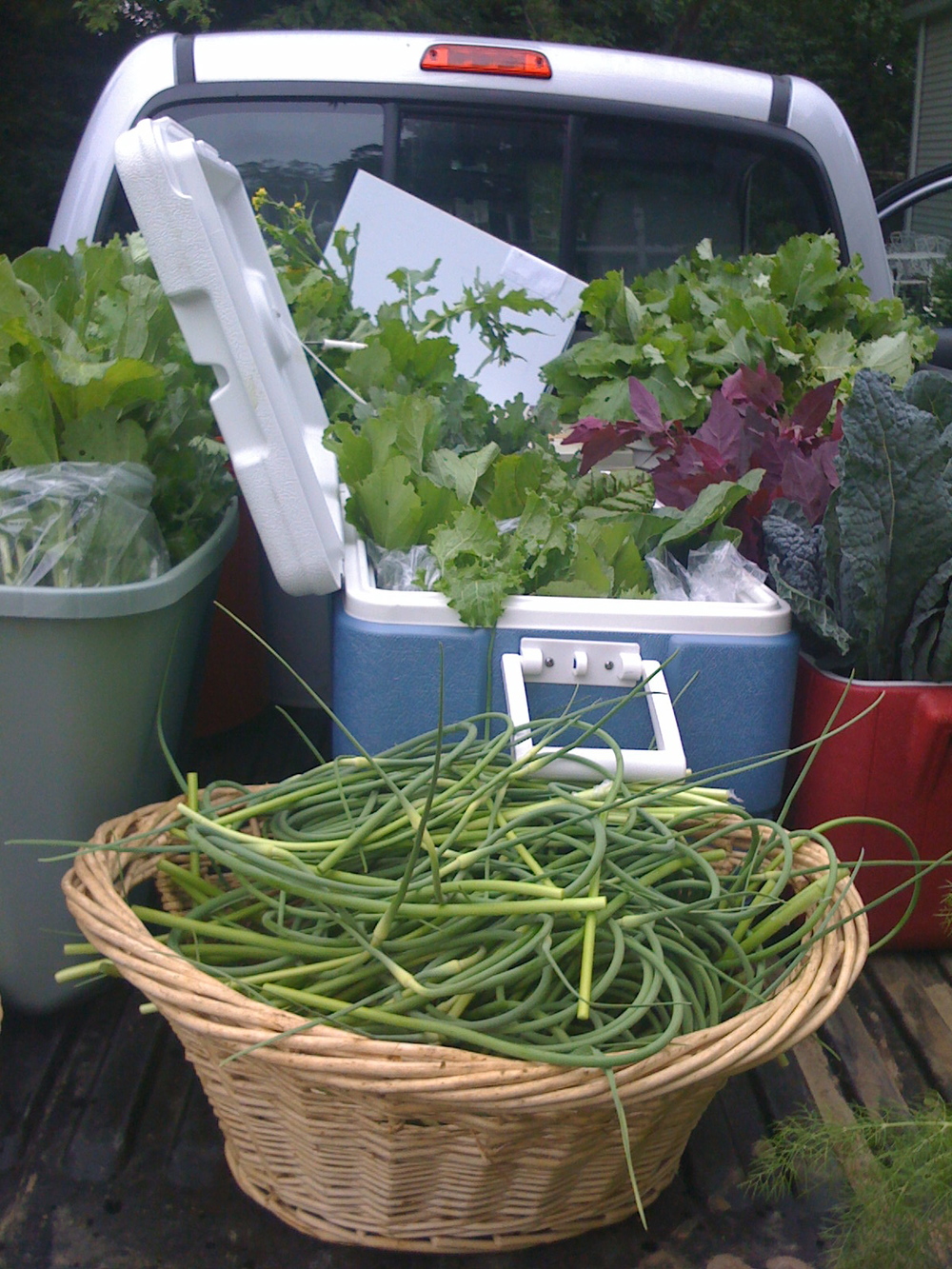 Scapes on the way to market, June 20Softneck garlic has, you guessed it, a softer stalk; these varieties of garlic have many small cloves covered by a silvery thin skin. (We grow Silverwhites and Inchelium Red.) Softnecks last longer in storage, and can be planted mechanically, two reasons why supermarkets carry that type almost exclusively. Hardnecks take a little more labor, as they have to planted by hand in a particular way, and their "scapes"--the curly green tops that appear only for a short while in spring, and that taste like garlicky scallions--have to be pulled by hand.
Scapes on the way to market, June 20Softneck garlic has, you guessed it, a softer stalk; these varieties of garlic have many small cloves covered by a silvery thin skin. (We grow Silverwhites and Inchelium Red.) Softnecks last longer in storage, and can be planted mechanically, two reasons why supermarkets carry that type almost exclusively. Hardnecks take a little more labor, as they have to planted by hand in a particular way, and their "scapes"--the curly green tops that appear only for a short while in spring, and that taste like garlicky scallions--have to be pulled by hand.  So, to plant hardneck garlic: using some kind of implement, dig holes around four-five inches deep and about one-two inches wide; there's a tool for that called a dibble (the wooden tool in the picture to the left). The holes should be about six inches apart.
So, to plant hardneck garlic: using some kind of implement, dig holes around four-five inches deep and about one-two inches wide; there's a tool for that called a dibble (the wooden tool in the picture to the left). The holes should be about six inches apart. Eight little cloves, ready to sleep for the winterThen you simply place each clove, root end down, in one of the holes. The pointed tip should be about 2 inches from the surface. Finally, tuck the cloves in with some dirt and cover the whole area with mulch.
Eight little cloves, ready to sleep for the winterThen you simply place each clove, root end down, in one of the holes. The pointed tip should be about 2 inches from the surface. Finally, tuck the cloves in with some dirt and cover the whole area with mulch.
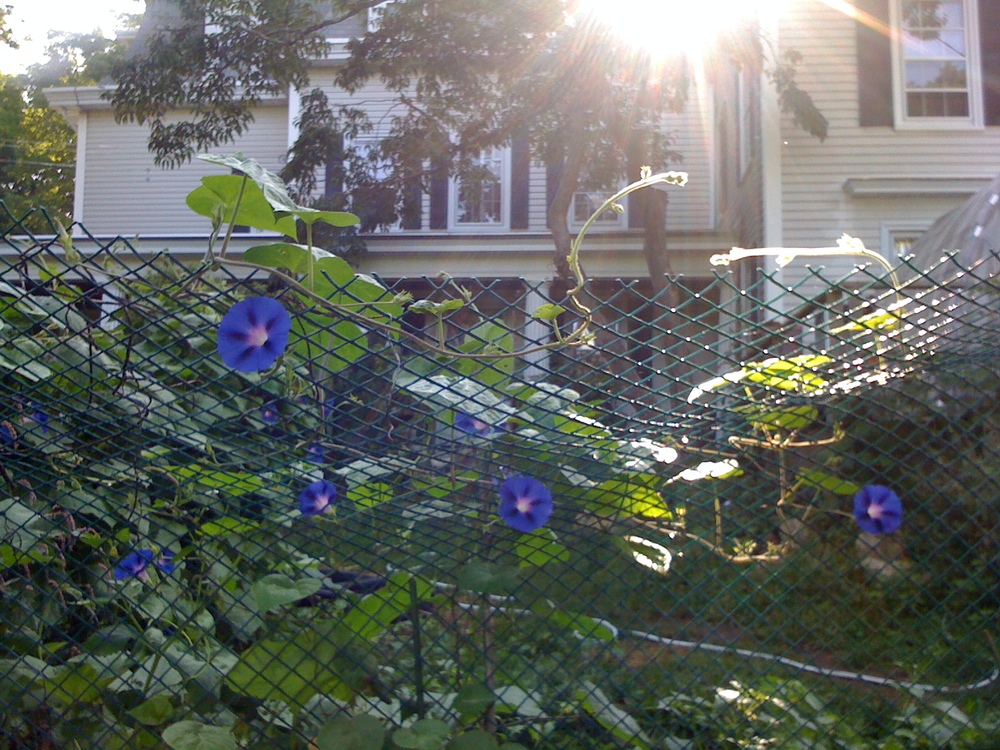





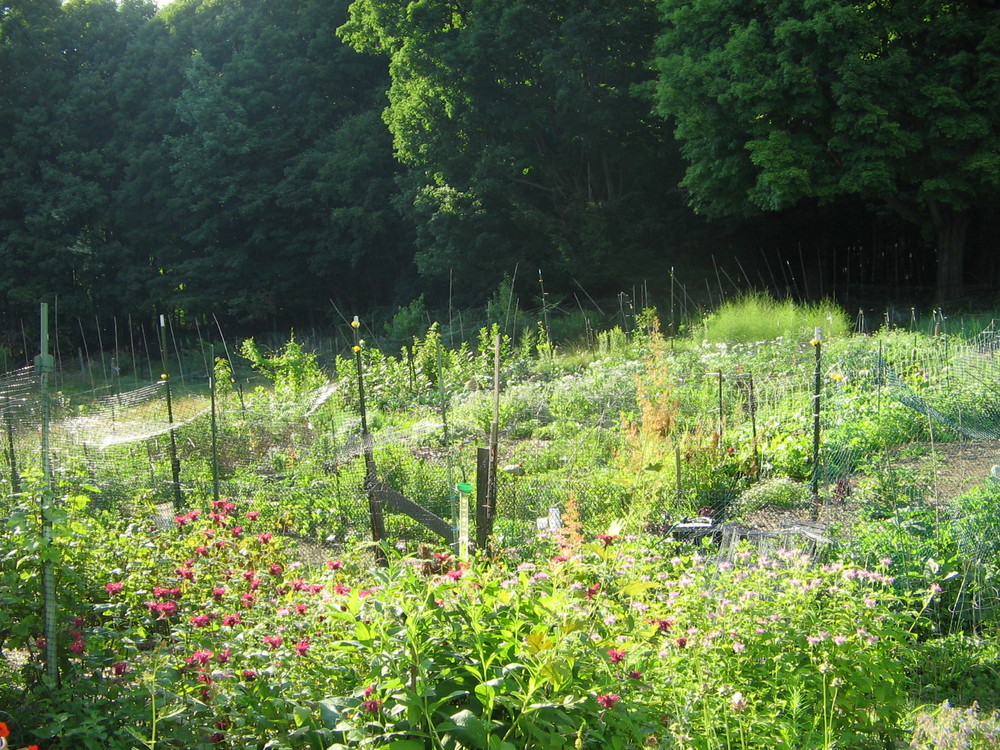
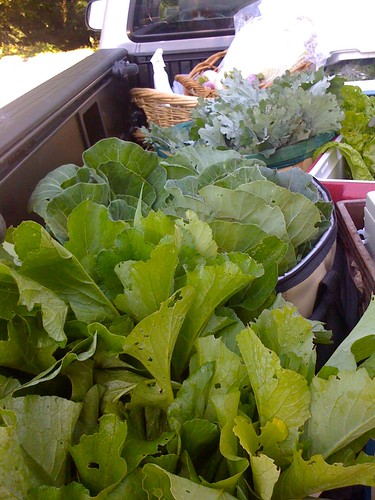


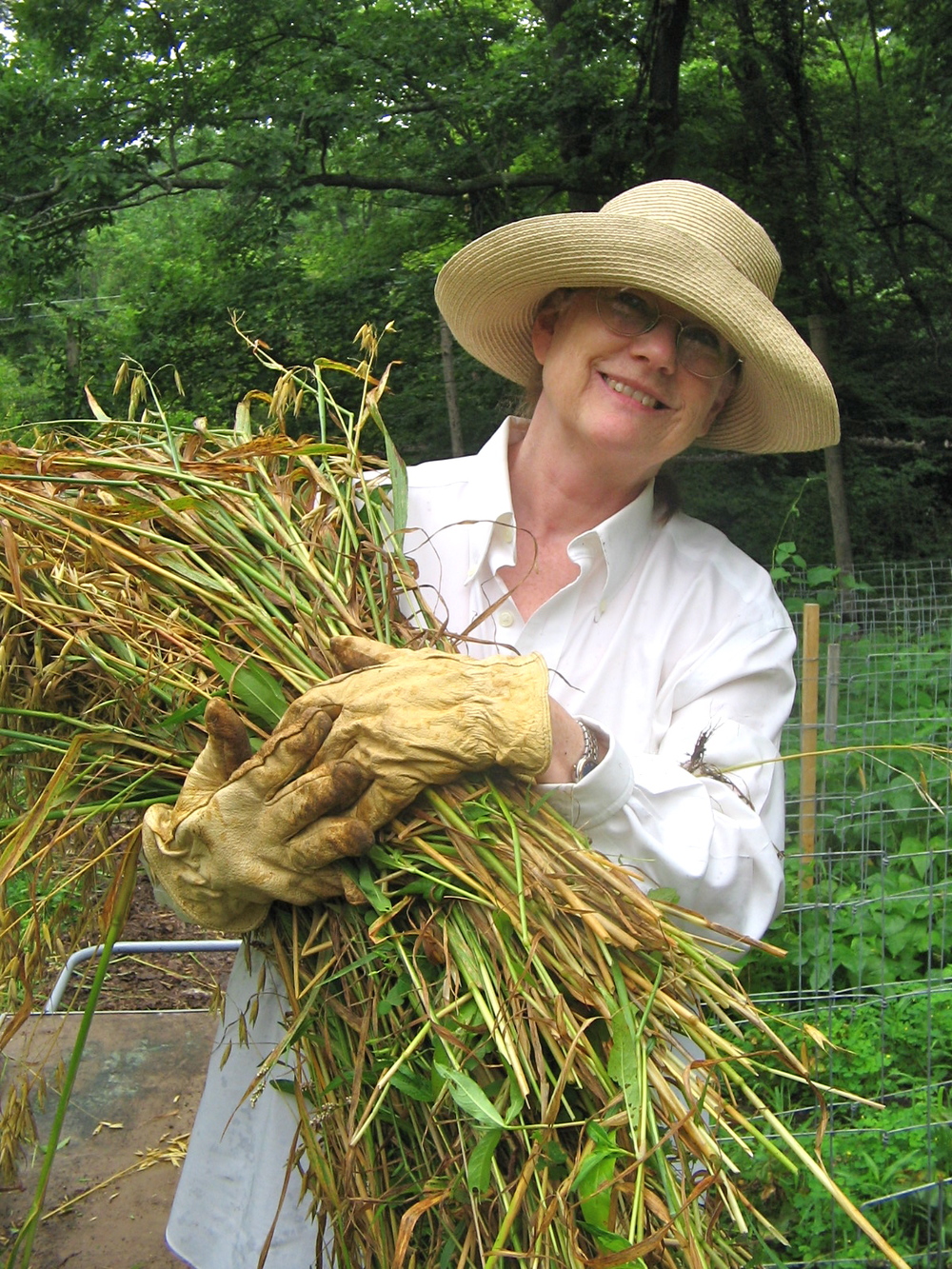


 I'm learning to value the small things, an unanticipated benefit of getting frugal. Today, I splurged. I bought myself a croissant, and I'm surprised to find how happy this one little treat had made me. I've cut out Starbucks and other on-the-go food purchases, buying and making coffee at the office with my coworkers, and bringing lunch and snacks almost every day. I also stopped buying water because of the plastic waste. Reducing those everyday expenses has made me more aware when i think about buying other items, both in terms of saving money and reducing waste--and more and more the cash I withdraw is lasting longer and longer.
I'm learning to value the small things, an unanticipated benefit of getting frugal. Today, I splurged. I bought myself a croissant, and I'm surprised to find how happy this one little treat had made me. I've cut out Starbucks and other on-the-go food purchases, buying and making coffee at the office with my coworkers, and bringing lunch and snacks almost every day. I also stopped buying water because of the plastic waste. Reducing those everyday expenses has made me more aware when i think about buying other items, both in terms of saving money and reducing waste--and more and more the cash I withdraw is lasting longer and longer.